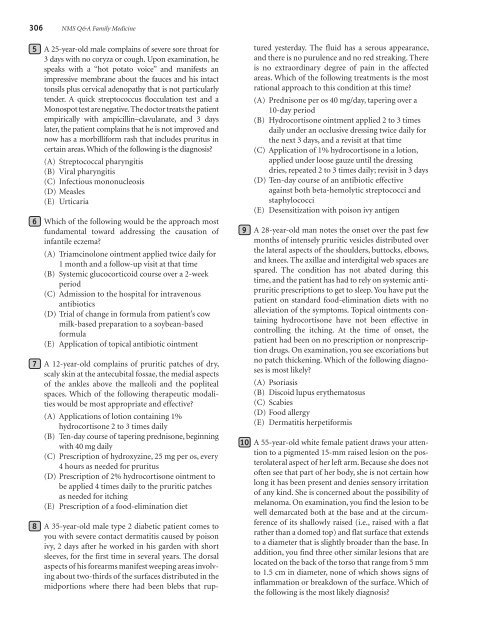NMS Q&A Family Medicine
NMS Q&A Family Medicine
NMS Q&A Family Medicine
- No tags were found...
You also want an ePaper? Increase the reach of your titles
YUMPU automatically turns print PDFs into web optimized ePapers that Google loves.
306 <strong>NMS</strong> Q&A <strong>Family</strong> <strong>Medicine</strong>5 A 25-year-old male complains of severe sore throat for3 days with no coryza or cough. Upon examination, hespeaks with a “hot potato voice” and manifests animpressive membrane about the fauces and his intacttonsils plus cervical adenopathy that is not particularlytender. A quick streptococcus flocculation test and aMonospot test are negative. The doctor treats the patientempirically with ampicillin–clavulanate, and 3 dayslater, the patient complains that he is not improved andnow has a morbilliform rash that includes pruritus incertain areas. Which of the following is the diagnosis?(A) Streptococcal pharyngitis(B) Viral pharyngitis(C) Infectious mononucleosis(D) Measles(E) Urticaria6 Which of the following would be the approach mostfundamental toward addressing the causation ofinfantile eczema?(A) Triamcinolone ointment applied twice daily for1 month and a follow-up visit at that time(B) Systemic glucocorticoid course over a 2-weekperiod(C) Admission to the hospital for intravenousantibiotics(D) Trial of change in formula from patient’s cowmilk-based preparation to a soybean-basedformula(E) Application of topical antibiotic ointment7 A 12-year-old complains of pruritic patches of dry,scaly skin at the antecubital fossae, the medial aspectsof the ankles above the malleoli and the poplitealspaces. Which of the following therapeutic modalitieswould be most appropriate and effective?(A) Applications of lotion containing 1%hydrocortisone 2 to 3 times daily(B) Ten-day course of tapering prednisone, beginningwith 40 mg daily(C) Prescription of hydroxyzine, 25 mg per os, every4 hours as needed for pruritus(D) Prescription of 2% hydrocortisone ointment tobe applied 4 times daily to the pruritic patchesas needed for itching(E) Prescription of a food-elimination diet8 A 35-year-old male type 2 diabetic patient comes toyou with severe contact dermatitis caused by poisonivy, 2 days after he worked in his garden with shortsleeves, for the first time in several years. The dorsalaspects of his forearms manifest weeping areas involvingabout two-thirds of the surfaces distributed in themidportions where there had been blebs that rupturedyesterday. The fluid has a serous appearance,and there is no purulence and no red streaking. Thereis no extraordinary degree of pain in the affectedareas. Which of the following treatments is the mostrational approach to this condition at this time?(A) Prednisone per os 40 mg/day, tapering over a10-day period(B) Hydrocortisone ointment applied 2 to 3 timesdaily under an occlusive dressing twice daily forthe next 3 days, and a revisit at that time(C) Application of 1% hydrocortisone in a lotion,applied under loose gauze until the dressingdries, repeated 2 to 3 times daily; revisit in 3 days(D) Ten-day course of an antibiotic effectiveagainst both beta-hemolytic streptococci andstaphylococci(E) Desensitization with poison ivy antigen9 A 28-year-old man notes the onset over the past fewmonths of intensely pruritic vesicles distributed overthe lateral aspects of the shoulders, buttocks, elbows,and knees. The axillae and interdigital web spaces arespared. The condition has not abated during thistime, and the patient has had to rely on systemic antipruriticprescriptions to get to sleep. You have put thepatient on standard food-elimination diets with noalleviation of the symptoms. Topical ointments containinghydrocortisone have not been effective incontrolling the itching. At the time of onset, thepatient had been on no prescription or nonprescriptiondrugs. On examination, you see excoriations butno patch thickening. Which of the following diagnosesis most likely?(A) Psoriasis(B) Discoid lupus erythematosus(C) Scabies(D) Food allergy(E) Dermatitis herpetiformis10 A 55-year-old white female patient draws your attentionto a pigmented 15-mm raised lesion on the posterolateralaspect of her left arm. Because she does notoften see that part of her body, she is not certain howlong it has been present and denies sensory irritationof any kind. She is concerned about the possibility ofmelanoma. On examination, you find the lesion to bewell demarcated both at the base and at the circumferenceof its shallowly raised (i.e., raised with a flatrather than a domed top) and flat surface that extendsto a diameter that is slightly broader than the base. Inaddition, you find three other similar lesions that arelocated on the back of the torso that range from 5 mmto 1.5 cm in diameter, none of which shows signs ofinflammation or breakdown of the surface. Which ofthe following is the most likely diagnosis?
















